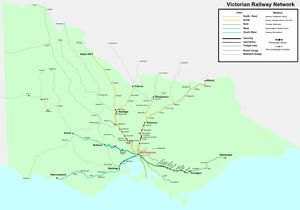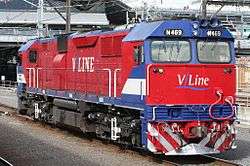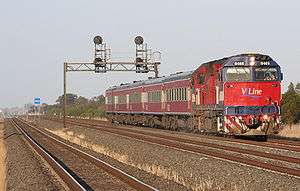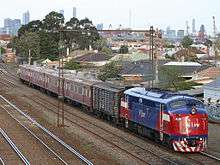V/Line
 | |
| Government-owned corporation | |
| Industry | Rail & coach transport |
| Founded | 1 July 1983 |
| Headquarters | Melbourne, Australia |
Area served |
Regional Victoria Adelaide Canberra Southern New South Wales |
Key people |
Jenny Dawson Chairman Gary Liddle acting CEO |
| Services | Regional trains and coaches |
| Revenue | $618.8 (2014/15) |
|
| |
Number of employees | 1,586 (June 2015) |
| Parent | Government of Victoria |
| Website | www.vline.com.au |
 Victorian railway network in 2007 | |
| Locale | Victoria, Australia |
|---|---|
| Dates of operation | 1 July 1983– |
| Predecessor |
Victorian Railways Public Transport Corporation |
| Track gauge |
1,600 mm (5 ft 3 in) 1,435 mm (4 ft 8 1⁄2 in) (Albury line) |
| Headquarters | Melbourne |
V/Line is a government-owned corporation that operates the regional passenger train and coach services in Victoria, Australia. It was created after the split-up of VicRail in 1983. V/Line is owned by the V/Line Corporation which is a Victorian State Government statutory authority.
V/Line carried 15.05 million passengers in the 2014/15 financial year. V/Line is also track manager of the Victorian intrastate rail network outside of the Australian Rail Track Corporation and Metro Trains Melbourne leases.[1] As at June 2015, it operated 90 stations, 41 locomotives, 134 locomotive hauled carriages and 179 diesel multiple unit carriages.[2]
As a government authority
On 1 July 1983, the State Transport Authority and a range of other transport bodies were created, when the Transport Act 1983 came into effect.[3] The new authority replaced VicRail, and established the V/Line operating brand for both country passenger and freight. The VicRail orange and silver 'teacup' livery used on passenger rolling stock was replaced in August 1983 by an orange and grey livery. The white and green V/Line logo was launched on 14 August 1983 by the then Minister of Transport, Steve Crabb, at Spencer Street station, with special trains running to Essendon to mark the occasion.[4][5]
This was altered when on 1 July 1989 the Transport (Amendment) Act took effect, merging the State Transport Authority with the Metropolitan Transit Authority to form the Public Transport Corporation.[6] The relationship between the country V/Line and suburban 'The Met' brands was blurred, with the Sprinter trains delivered in the 1993-1995 period appearing in PTC colours but with both PTC and V/Line logos.[7]
In 1995, the freight and passenger rail divisions of V/Line were divided, with a new red, blue and white V/Line Passenger livery unveiled, which remains on some of the fleet today.[8] This split was finalised on 1 July 1997 when separate management was brought in.[9]
V/Line Freight was sold to a consortium of RailAmerica, Fluor Daniel, Macquarie Bank and A Goninan & Co and rebranded as Freight Victoria effective from 1 May 1999.[10][11][12]
V/Line Passenger was franchised with National Express beating Freight Victoria.[13][14][15][16] The V/Line Freight contract included a 45-year lease from the government of most regional track (passenger and freight), with responsibilities for track, signalling and level crossings, with access to passenger sections of track granted to V/Line Passenger.
V/Line operates under a franchise agreement entered into with the Director of Public Transport. The Director also sub leases tracks and other infrastructure which the Director holds under lease from VicTrack, the agency which owns Victoria's rail-related land and infrastructure.
As a corporation
On 29 August 1999, National Express took control of V/Line Passenger.[17] It included all country rail operations in Victoria, with the exception of the West Coast Railway operated Warrnambool line and the Hoys Roadlines operated Shepparton line, previously franchised in 1993.[17] In 2004, operational difficulties hit the two privately operated lines, and they came back under the control of V/Line.
In December 2002, National Express handed in its Victorian rail and tram franchises having been unable to renegotiate financial terms with the State Government.[18][19][20]
Full control was taken on 1 October 2003 by changing the shareholding of V/Line, making the government the sole shareholder via a recently created statutory corporation, V/Line Passenger Corporation.[1]
In 2000, the Regional Fast Rail project was launched to upgrade the tracks linking Ballarat, Bendigo, Geelong and the Latrobe Valley to Melbourne. The project, which also included new rolling stock and an expanded timetable of rail services, commenced full operations from December 2005.
In November 2006 Pacific National, who had purchased Freight Australia, entered into an agreement to sell the remainder of its Victorian rail lease of the network back to the Victorian Government for $133.8 m.[21] The sale was completed on 7 May 2007, with V/Line becoming the track manager of the Victorian intrastate network.[22]
In May 2008 it was announced that part of the V/Line fleet would be converted to standard gauge to operate an upgraded Albury line service.[23] In December 2008 V/Line ended the sale of alcoholic beverages aboard long-distance trains, after almost a century of the practice.[24]
In 2014/15, the subsidy per passenger trip was $20.17.[2]
The Transport Integration Act renamed the V/Line Passenger Corporation as V/Line Corporation.[25] The Act also gave V/Line a new statutory charter. As part of these changes, the corporation's responsibilities were explicitly expanded to cover both rail passenger and rail freight services.[26] The Act received the Royal Assent on 2 March 2010 and came into operation on 1 July 2010.[27]
In January 2016, V/Line's VLocity rolling stock was identified to be suffering from abnormal wheel wear,[28] in addition to the fleet being banned from the Metropolitan track lease by the suburban rail operator, Metro Trains Melbourne, after failing to activate a level crossing in Dandenong,[29][30] in turn causing as many as 70 services a day to be cancelled.[31] This resulted in the resignation of then CEO Theo Taifalos, sixteen days free travel being provided to passengers, and an independent inquiry being ordered by Transport Minister Jacinta Allan into the operational capacity of V/Line.[31][32]
Services

V/Line operates rail services to the regional cities of Ballarat, Bendigo, Geelong, Seymour and Traralgon as well as Ararat, Maryborough, Echuca, Swan Hill, Albury, Bairnsdale, Warrnambool and Shepparton. In addition, V/Line road coaches connect with many rail services at major stations to serve towns away from the main rail network operating as far as Adelaide and Canberra.[33]
Rail services are grouped into two types. As part of the introduction of the Myki smartcard in 2013, and to provide consistent communication to both staff and customers, what were formerly called "Interurban" services became "Commuter" services, and what were formerly called "Intercity" services became "Long Distance" services. Commuter services operate over shorter distances and more frequently than Long Distance services, and the latter usually provide some first-class accommodation, as well as snack bar facilities.
All rail services depart from Southern Cross station in Melbourne on the following lines with the exception of one Traralgon service which departs/ terminates at Flinders Street
- South West Region or Geelong Line which continues as the Warrnambool Line
- Western Region or Ballarat Line which continues as the Ararat Line and the Maryborough Line
- Northern Region or Bendigo Line which extends as the Swan Hill Line and the Echuca Line
- North East Region or Seymour Line which extends as the Shepparton Line and the Albury Line
- Eastern Region or Traralgon Line which continues as the Bairnsdale Line
Rail services once extended to Dimboola, Mildura, Cobram and Leongatha but were discontinued in 1993.[34]
The services to Ararat and Bairnsdale were also withdrawn in 1993, but restored in 2004.[35] In December 2008, as part of the Victorian Transport Plan, the state government announced that V/Line rail passenger services would be extended from Ballarat to Maryborough station at a cost of $50 million, commencing in July 2010.[36][37] The first passenger train in 15 years arrived at Maryborough on 24 July 2010.[38]
The resumption of V/Line services to Leongatha and Cobram has been sought by communities along both of these lines, but minimal portions of the track along both corridors has now been removed. The resumption of services to Mildura has also been floated ever since it ceased operation, however, despite much planning, little action has been achieved. A recent report into the extensions of the Melbourne metropolitan rail system identified the population growth corridor from Cranbourne to Koo-Wee-Rup along the disused Leongatha line as a key planning priority.[39]
V/line also runs numerous intrastate and interstate road coach services that may run wholly as a coach service or operate as a coach connecting with a rail service.
Interstate road coach service operated by V/line are:
- Canberra Link - Melbourne (Southern Cross) - Canberra via Albury, runs as a train to Albury and then a coach to Canberra
- Capital Link - Melbourne (Southern Cross) - Canberra via Bairnsdale, runs as a train to Bairnsdale and then a coach to Canberra
- Daylink - Melbourne (Southern Cross) - Adelaide via Bendigo, runs as a train to Bendigo and then a coach to Adelaide
- Sapphire Coast Link - Melbourne (Southern Cross) - Batemans Bay via Bairnsdale, runs as a train to Bairnsdale and then a coach to Batemans Bay
- Speedlink - Sydney - Adelaide via Albury, does not travel to Melbourne and runs as the NSW TrainLink XPT train from Sydney to Albury and then a coach from Albury to Adelaide
- Murraylink - Mildura - Albury, does not travel to Melbourne and operates entirely as a coach.
Ticketing

V/Line currently uses the myki ticketing system on short distance train services, in addition to machine printed paper tickets, issued from staffed V/Line stations, selected Metro suburban premium stations, V/Line ticket agents, online or by phone. Passengers boarding services at unmanned stations or roadside coach stops can purchase tickets from the train conductor or coach driver.
Tickets have the origin and destination printed upon them, making them point to point, but the fare itself is based on charging zones.[40] Changes were made to the fare system, to integrate it with the suburban Metcard system in preparation for the introduction of the Myki smartcard system to cover the entire state.[41]
Ticket types available include single, return, and a range of periodical tickets.[42] Services are classified as peak and off-peak, with discounts available for tickets valid in off-peak times only.[42] V/Line operates a limited number of trains with first class seating which requires the payment of an upgrade fee on top of the standard economy fare.[43] From June 2013 the Myki smartcard system began to be rolled out on the V/Line network.[44]
Most V/Line services operate on a non-allocated seating basis, but all intercity (long distance) rail services and some coach services require seat reservations.[45]
Fleet
| Class | Image | Type | Gauge | Top speed (km/h) |
Built | Number | Notes |
| VLocity |  |
Diesel multiple unit | Broad | 160 | 2004- | 134 | 51 sets, 43 additional cars under construction |
| N class |  |
Diesel electric locomotive | Broad, Standard | 130 | 1985-1987 | 25 | |
| Sprinter | Diesel multiple unit | Broad | 130 | 1993-1995 | 21 | ||
| A class | Diesel electric locomotive | Broad | 133 | 1984-1985 | 11 | 10 stored | |
| P class | Diesel electric locomotive | Broad, Standard | 100 | 1984-1985 | 8 | 1 stored | |
| Y class |  |
Diesel electric locomotive | Broad | 65 | 1965-1968 | 4 | Shunters at Southern Cross, Geelong and Newport Workshops |
| H type carriages | Passenger carriage | Broad | 115 | 1984-1990 | 51 | 13 sets, 1 car stored | |
| N type carriages |  |
Passenger carriage | Broad, Standard | 115 | 1981-1984 | 56 | 19 sets, 1 car stored (accident damage) |
| Z type carriages | Passenger carriage | Broad | 115 | 1957-1966 | 20 | Incorporated into N sets, 1 stored (accident damage) | |
| D van |  |
Parcels/luggage van | Broad | 115 | 1983 | 7 | 4 stored |
| PCJ van |  |
Head end power/luggage van | Standard | 115 | 1970 | 3 | |
| PH van |  |
Head end power van | Broad | 115 | 1984, 2009 | 4 |
Road coaches:

Road coaches are provided by private companies, who are contracted by the Department of Transport to operate services for V/Line. These coaches are painted in V/Line livery.[46]
Network access
V/Line also manages and maintains all non-interstate rural rail track in Victoria, including lines that do not see passenger services.[47] The lease was previously held by Pacific National, who entered into an agreement to sell it back to the Victorian Government for $133.8 million in November 2006,[21] with the sale completed in May 2007 with V/Line appointed to manage it.[48]
Branding

The initial V/Line visual identity was unveiled in August 1983, with an orange and grey livery for locomotives and passenger rolling stock,[4] along with a white and green V/Line logo with a "stylised capital lettered logo with the V and the L split by a deep slashing stroke".[49] Work on the initial V/Line identity started in May 1983, with freight wagons being released without logos pending the launch. Before that time, a stylised VR logo was carried by rolling stock that had been received the orange and silver VicRail 'teacup' livery since 1981.[4] Carriages in the 'teacup' livery later had the logos removed and replaced by V/Line ones.[50]
This remained until 1993 when the Sprinter trains were delivered in the teal and yellow suburban 'The Met' brand colours, but with both The Met and V/Line logos.[7] In 1995, the freight and passenger rail divisions of V/Line were divided, with locomotives in the freight fleet retaining the orange and grey livery with 'V/Line Freight' logos, while passenger carriages and locomotive received the red blue and white 'V/Line Passenger' livery which remains on some of the fleet today.[8] It was also at that time that the V/Line logo was altered, with serifs added to the lettering, and the "deep slashing stroke" was altered to a curved blue line. After National Express took over V/Line, the logo was again altered in 2000, with mixed-case lettering and a curving blue line underneath.[50] In 2006, it was again altered, with the removal of the blue line underneath and addition of a purple line.[51]
The VLocity railcars were delivered from 2005 in a totally new livery of stainless steel with purple and green highlights. In 2007, a new livery was unveiled, consisting of a grey carbody with red, white and purple stripes.[52] Rolling stock in different variants of the livery was released throughout that year, with a consistent version not appearing until 2008, along with a number of repainted locomotives.
See also
- Chief Investigator, Transport Safety
- Department of Transport
- Director of Public Transport
- Director, Transport Safety
- Rail Safety Act
- Rail transport in Victoria
- Transport Integration Act
- VicTrack
References
- 1 2 "V/Line Background". www.vline.com.au. Retrieved 2008-03-27.
- 1 2 Annual Report for year ended 30 June 2015 V/Line
- ↑ "Public Record Office Victoria online catalogue". access.prov.vic.gov.au. Retrieved 2008-03-16.
- 1 2 3 Railmac Publications (1992). Australian Fleetbooks: V/Line locomotives. Kitchner Press. p. 5. ISBN 0-949817-76-7.
- ↑ "Index Page". Newsrail. Australian Railway Historical Society. September 1983. p. 227.
- ↑ "Public Record Office Victoria online catalogue". access.prov.vic.gov.au. Retrieved 2008-03-16.
- 1 2 "V/LineCars.com - Sprinters". www.vlinecars.com. Archived from the original on 2008-03-07. Retrieved 2008-03-16.
- 1 2 "News". Newsrail. Australian Railway Historical Society (Victorian Division). November 2005.
- ↑ Peter Attenborough (June 2004). "Freight Australia". Australian Model Railway Magazine. pp. 24–27.
- ↑ RailAmerica Backed Freight Victoria Consortium Wins Australian V/Line Freight Bid Business Wire 22 February 1999
- ↑ Rail giants to battle for Freight Australia The Age 1 November 2003
- ↑ "Freight Victoria Bid Wins V/Line Freight" Railway Digest March 1999 page 9
- ↑ First Melbourne franchise Railway Gazette International 1 July 1999
- ↑ National Express Group Awarded Three Franchises National Express June 1999
- ↑ National Express takes root in Melbourne Railway Gazette International 1 October 2000
- ↑ Railamerica Wins In Australia - Freight Victoria consortium led by RailAmerica Inc. acquires V/Line Freight Railway Age March 1999
- 1 2 Peter Attenborough (June 2006). "V/Line Passenger". Australian Model Railway Magazine. pp. 26–29.
- ↑ National Express walks out of Australian rail service The Daily Telegraph (London) 17 December 2002
- ↑ Richard Web (14 March 2004). "The long goodbye". The Age. Retrieved 2008-02-17.
- ↑ Nat Express pull back Down Under The Daily Telegraph (London) 3 September 2004
- 1 2 "Toll sells rail lease". Canberra Times. 2 November 2006. p. 17.
- ↑ "Media Release: Rail Buy Back Deal Complete". Minister for Public Transport. www.legislation.vic.gov.au. 7 May 2007. Retrieved 2008-03-27.
- ↑ "Premier of Victoria, Australia - Federal-State Co-operation Delivers Major Rail Project". www.premier.vic.gov.au. Retrieved 2008-05-30.
- ↑ Kate Lahey (23 December 2008). "No more making a V/Line for the bar". The Age. theage.com.au. Retrieved 2008-12-23.
- ↑ "Transport Integration Act 2010 (No 6 of 2010) - Section 128 V/Line Corporation". www.austlii.edu.au. Retrieved 2010-06-04.
- ↑ "Transport Integration Act 2010 (No 6 of 2010) - Section 131 Object of V/Line Corporation". www.austlii.edu.au. Retrieved 2010-06-04.
- ↑ "New Transport Framework For Victoria". Mondaq Business Briefing. www.thefreelibrary.com. 30 March 2010. Retrieved 2010-06-04.
- ↑ Carey, Adam (2016-01-14). "V/Line trains forced out of service by mysterious wheel fault". The Age. Retrieved 29 January 2016.
- ↑ http://www.theage.com.au/victoria/boom-gate-safety-issues-with-vline-vlocity-trains-known-for-more-than-two-years-20160119-gm9lkj.html
- ↑ http://www.heraldsun.com.au/news/wheel-issue-heat-delays-regional-commuters-on-vline-trains/news-story/aba6a48efb70866db71807356fe0aef4
- 1 2 "Victorians afforded free regional rail travel after week of V/Line delays". ABC News. 2016-01-20. Retrieved 29 January 2016.
- ↑ "V/Line chief Theo Taifalos resigns after long delays, free travel extended into February". ABC News. 2016-01-28. Retrieved 29 January 2016.
- ↑ Timetables V/Line
- ↑ Chris Banger (March 1997). "Rail Passenger Service Withdrawals Since 1960". Newsrail. Australian Railway Historical Society (Victorian Division). pp. 77–82.
- ↑ Liz Gooch (10 July 2004). "Ararat sleepers awake to new sound - the train". The Age. www.theage.com.au. Retrieved 2010-09-04.
- ↑ "Maryborough Rail Extension Projects". Victorian Transport Plan. www4.transport.vic.gov.au. Retrieved 2008-12-08.
- ↑ "Maryborough Rail Services". Victorian Transport Plan. www.transport.vic.gov.au. Retrieved 2010-07-05.
- ↑ "Maryborough gets its train back". Transport Projects eNews August 2010. Department of Transport. Retrieved 2013-07-08.
- ↑ http://www.mpa.vic.gov.au/wp-content/uploads/2014/03/PSP-54-Leongatha-Rail-Line-Peer-Review-Aurecon-Rev-1-FINAL-DRAFT-Appendix-2-10.pdf
- ↑ remove outdated Metlink info
- ↑ "V/Line - V/Line & Metlink ticket integration". www.vline.com.au. Retrieved 2008-03-27.
- 1 2 "V/Line - Fares - Ticket Types & Conditions". www.vline.com.au. Retrieved 2008-03-27.
- ↑ "V/Line ~ First Class". www.vline.com.au. Retrieved 2008-03-27.
- ↑ myki to start on V/Line commuter services Public Transport Victoria 11 June 2013
- ↑ "V/Line - Reservations". www.vline.com.au. Retrieved 2008-03-27.
- ↑ "V/Line - Our Fleet". www.vline.com.au. Retrieved 2008-03-27.
- ↑ "Introduction to RNA". V/Line ~ Network Access. www.vline.com.au. Retrieved 2008-10-14.
- ↑ "Rail Buy Back Deal Complete". Minister for Public Transport (Media Release). 7 May 2007. Retrieved 2008-02-05.
- ↑ Norm Bray & Peter J Vincent (2006). Bogie Freight Wagons of Victoria. Brief History Books. p. 14. ISBN 0-9775056-0-X.
- 1 2 "V/LineCars.com - Carriage Liveries". vlinecars.com. Archived from the original on 19 August 2008. Retrieved 2008-10-16.
- ↑ "V/LineCars.com News - 22nd August 2006 - New V/Line Logo". www.vlinecars.com. Retrieved 2008-10-16.
- ↑ "V/LineCars.com - Carriage and Sprinter Refurbishment Program & New V/Line Livery - Ministerial & Media Launch". www.vlinecars.com. Archived from the original on 20 July 2008. Retrieved 2008-10-16.
External links
 Media related to V/Line at Wikimedia Commons
Media related to V/Line at Wikimedia Commons- V/Line
- V/LineCars.com - Comprehensive V/Line Carriages Information & Enthusiast website
- Vicsig.net - Victorian passenger rolling stock
| Preceded by VicRail |
Country rail in Victoria 1983 - present |
Succeeded by Incumbent operator |